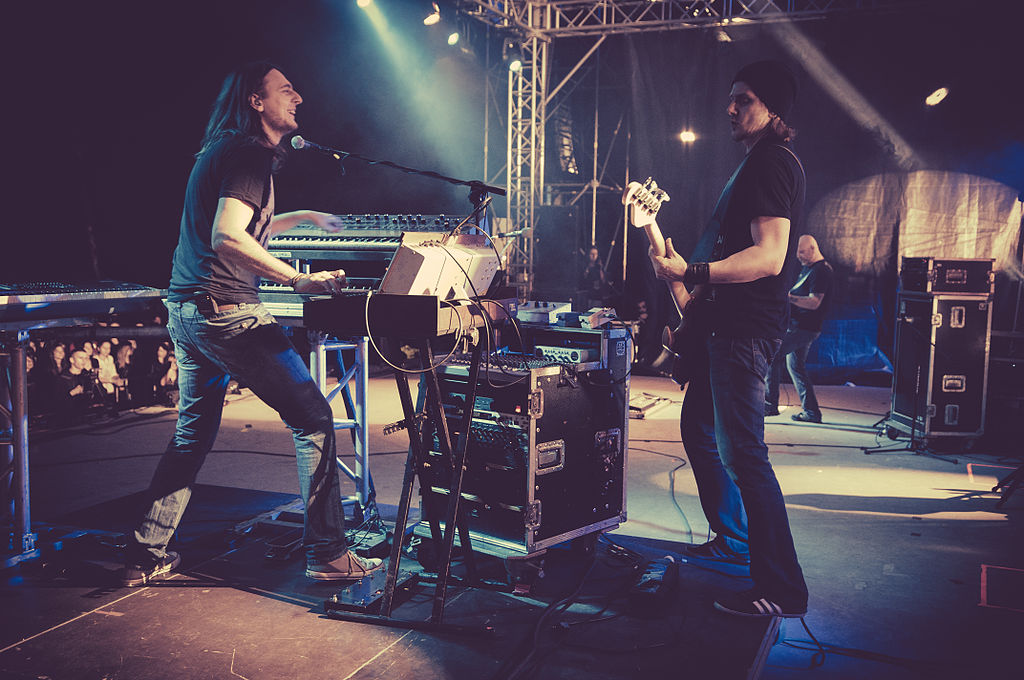Running though Silence at the Speed of Sound: Riverside’s Love, Fear and the Time Machine Gets the 5.1 Treatment

Before it became their most successful album, before the tragic death of guitarist Piotr Grudziński last February, and before darkness seemed to envelop the career of a band that was playing at their absolute peak and was poised to graduate to a new level of success, plans were already in motion for last week’s release of the latest Riverside album, Love, Fear and the Time Machine, as a deluxe edition remixed for the 5.1 Surround Sound format (as well as 24-bit Hi-Resolution Stereo) a year after the original release.
For the uninitiated (and simpletons like myself), 5.1 is an audio format that involves a five-speaker surround home theater configuration that, until relatively recently, was used primarily for film. In layman’s terms, it involves the normal two (left and right) speakers in front, a center room satellite speaker, and two surround speakers in the rear. There is some overlap and confusion here with SACD, DVD-A, and Hi-Res Audio (as well as probably a few other things) and I could spend many paragraphs detailing the nuances, but quite honestly, if you actually care about this stuff, you already know.
In this case, what you need to know is that the new deluxe version of Love, Fear and the Time Machine features the 24-bit Hi-Res version of the mix – which you can play on whatever systems you may already have, and more importantly, the 5.1 Surround Mix, which requires special equipment and the six speaker configuration described above. (It also has videos, bonus tracks, and various other bells and whistles…)
Perhaps surprisingly, considering all this confusion, a (not so) quiet 5.1 revolution has been building over the last decade or so. Maybe not so surprisingly, it’s coming largely from the progressive rock community – unsurprising since it is a genre full of music rich with the kind of sonic detail that greatly benefits from the expanded aural field the format offers. Steven Wilson (Porcupine Tree, No-Man, solo artist, producer, etc.) has become the go-to guy for these kind of remixes, and the résumé of classic bands he’s reworked reads like a who’s who of 1970’s progressive rock; King Crimson, Yes, Emerson, Lake and Palmer, and Jethro Tull are just some of the names you may have heard of, as well as slightly more recent favorites (his take on XTC’s Skylarking, for instance, will be released later this year.)

Bruce Soord is the guitarist/vocalist/songwriter and main force behind the British progressive band The Pineapple Thief, who are just about to release Your Wilderness, the 11th (and arguably best) album of a very prolific career. He is second only to Wilson in terms of promoting the 5.1 format, but, whereas SW tends towards working with established bands of the past, Soord works mainly with his contemporaries. He was the producer of Tim Bowness’ acclaimed 2015 album Stupid Things That Mean The World (in both 5.1 and conventional stereo), and was the first choice of Riverside‘s Mariusz Duda and Inside Out Records (Riverside‘s label outside of Poland, where it’s Mystic Production) to create the band’s first 5.1 deluxe edition. It was a natural fit – not only is Soord’s own music and production-style compatible, but The Pineapple Thief had toured with Riverside on several occasions, so they’ve known each other for years.
Soord was literally working on the album at the moment the tragic news came. “It was a very strange experience… I was in the middle of mixing, and it popped up on my Twitter feed that Piotr had died. So it was really quite a strange feeling to be mixing his guitar work and hear that terrible news.
“We must have done about 15 dates with them on the road, and I know the guys, so it was a bit of an emotional experience mixing that record. It was a really sad time, but such an honor and privilege to be able to work on it.”
Adding to that emotional weight is the heft of the album itself, an album that was originally inspired by, among other things, Mariusz’s journey of healing, affirmation, and the search for meaning after the loss of a childhood friend. “The lyrics to the album are quite melancholic and you can hear it in the songs and the way he sings about the past,” Bruce observes, “I find it really moving and it’s genuine as well. That’s what I really love about the album – it just feels really genuine and I think it comes across in the way Mariusz sings and in the performances… it was a really poignant mix to do.”
As for the format itself… well…
A personal anecdote, if you will pardon the indulgence:
I remember working in a record store in the 1980s, at the dawn of the CD era. There were certain guys (and yeah, it was ALWAYS guys) who would come into the store every Tuesday (which was new release day) to excitedly peruse what “new” old albums were reissued that week on this brand new cutting edge technology, this compact disc format that (they would excitedly all testify to anyone who would listen) sounded so superior to that old scratchy vinyl. It seems silly now, but they would seemingly buy ANYTHING – it could be Mozart, or Black Sabbath, or Willie Nelson, or New Kids on the Block – they weren’t listening to MUSIC, they were listening to CDS! The carrier had become more important than the content. It was the hysterical fervor of the newly converted, and if sometimes the zealotry of the 5.1 enthusiasts reminds me of those days, I have to remember that I have yet to experience the wonders of 5.1, and my cynicism is unfounded and unfair. And cynicism is ugly, you know? So my mind, and ears, are open.
Bruce completely understands my ambivalence. “No, I know… most people – people like you – just haven’t got the setup or had the opportunity to hear 5.1. But when I bring people into my studio and they do hear it, they say, ‘oh my god-this is incredible.’ When you compare it to stereo, it’s a different world. It’s a strange thing – the first time you hear it, it’s a bit ‘whoa – what is this? It’s so unnatural. I’ve got voices and keyboards behind me. I’ve got things all around me.’ But once you get over that, you just shut your eyes and…
“The audiophiles call it ‘immersive’ – they really like things to be immersive and that’s when it’s really a strong surround sound experience. You know, not just a little reverb added in the back, or a few added effects. They want it to be even all the way around them so it’s, as they say, a truly immersive experience.”
As for comparison with the original stereo Riverside mix, Bruce says, “I think you just hear the instruments in so much more space. You get to hear every component part of the mix – all of the guitars, all of the keyboard parts, all of the backing vocals. It’s no longer squashed into two speakers in a stereo field. They’re all around you. You can just hear stuff so much better.
“It’s amazing how many people out there are just obsessed with 5.1 as a format. What I’m trying to do, more than anything, is promote it, to get more people to hear it.” To that end, he hopes to literally take 5.1 on the road. “I’m talking with other bands, and we’re thinking of doing a little 5.1 listening tour… just to take the albums on the road and invite people down to hear it” and become, um, immersed, if you will.

In the Riverside camp, there is actually quite a bit of imminent activity, especially considering the tragedy that has necessitated an unwanted break in the band’s momentum. While they will not be physically regrouping until next year, the 22nd of October will see the release of the two-CD (or three-LP) Eye Of The Soundscape, a compilation of new, previously unreleased, remixed and reconstructed tracks of ambient electronica-oriented music. They had started assembling and recording it before Piotr Grudziński’s death and it was a personal dream of his for Riverside to make this stylistically very different kind of record as an “extra” project between official albums #6 and #7. The band finished it on what would have been his 41st birthday.
Also before Christmas, and once again in the works since before Grudziński’s death, a Riverside biography will be issued in Poland, although sadly at this time no English language version is scheduled.
Mariusz Duda has also been feverishly writing and recording a new album for his side project Lunatic Soul, and various other musical and non-musical ventures are coming from keyboardist Michał Łapaj and drummer Piotr Kozieradzki.
The legacy of Riverside, in Poland and in the world of progressive rock, is already assured and still growing. Just last month in Warsaw, the legendary band Collage – whose 1995 album Moonshine was enormously influential to every young Polish band – played Riverside‘s “The Depth of Self-Delusion” as an encore and it was a serendipitous moment of one great Polish artist paying tribute to another.
In fact, the band’s profile has never waned in the half year since Piotr Grudziński’s passing, and is unlikely to do so anytime soon. This new edition of Love, Fear and the Time Machine and the autumn release of Eye Of The Soundscape will very efficiently keep Riverside in the public consciousness until next year, at which time, I have no doubt, they will rise again and break this not-so-quiet silence.
It will, by necessity, be a different Riverside, and yet it will be a Riverside that has walked through the fire and emerged from the flames, blackened and burned around the edges, and yet resilient and even victorious – much like their country itself.
